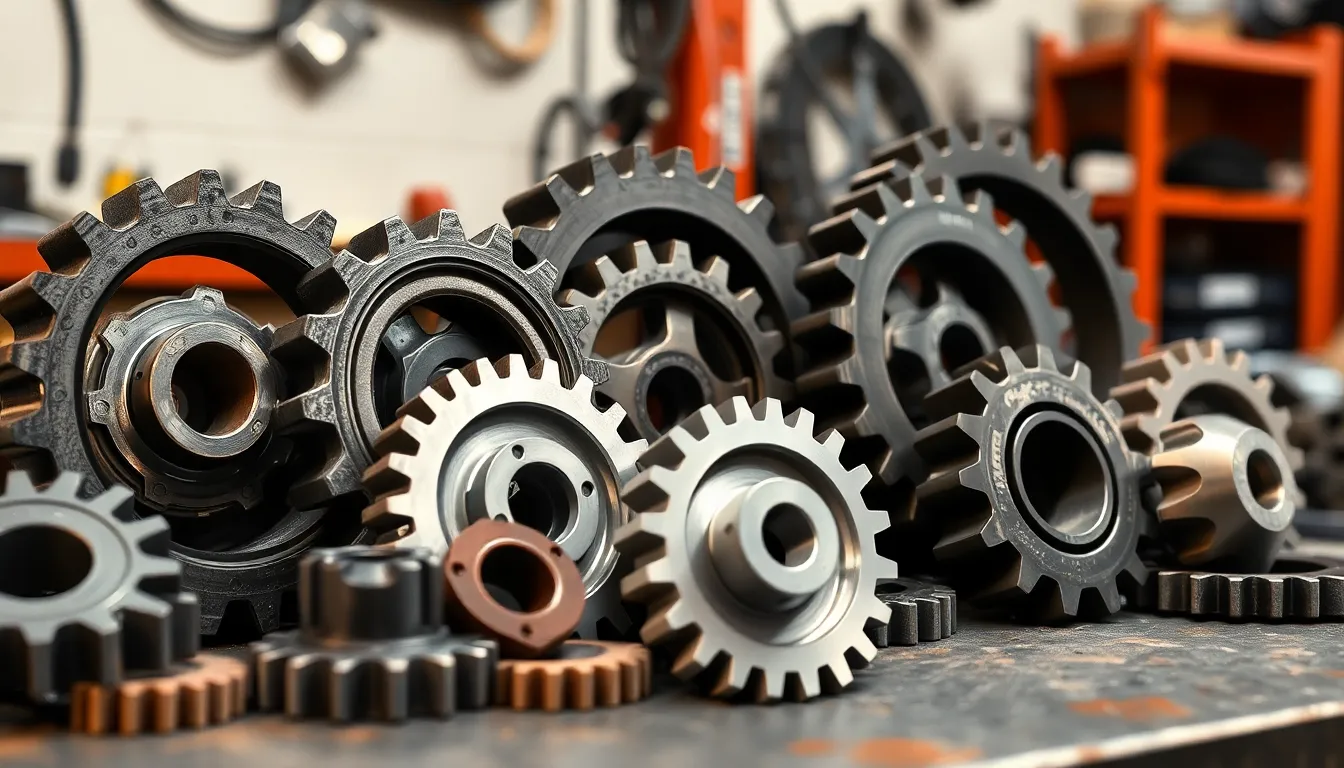In the world of automotive engineering, gear systems play a pivotal role in a vehicle’s performance and efficiency. From the moment the engine fires up to the final push on the accelerator, gears ensure that power is effectively transferred to the wheels. Understanding automotive gear not only enhances one’s appreciation for vehicle mechanics but also empowers drivers to make informed choices about maintenance and upgrades.
As technology advances, the variety of gears available has expanded dramatically, each designed for specific applications and driving conditions. Whether it’s the smooth shifting of an automatic transmission or the precise control of a manual gearbox, the right gear can dramatically influence a vehicle’s handling and fuel efficiency. Exploring the intricacies of automotive gear reveals the heart of what makes modern vehicles tick, paving the way for better driving experiences.
Table of Contents
ToggleOverview of Automotive Gear
Automotive gears play a vital role in vehicle mechanics, facilitating optimal performance and efficiency. Understanding the definitions, importance, and types of automotive gears aids in comprehending their significance in driving and maintenance.
Definition and Importance
Automotive gears are mechanical components designed to transmit power and torque between different parts of a vehicle. They excel in adjusting the engine’s rotational speed and enhancing the force delivered to the wheels. The importance of gears lies in their ability to improve vehicle acceleration, maintain stability, and increase overall fuel efficiency. Efficient gear systems can significantly influence the driving experience by enabling smoother transitions and better handling.
Types of Automotive Gear
Automotive gears can be classified into several types, each serving distinct purposes.
- Spur Gears: Spur gears feature straight teeth and are commonly used in manual transmissions. They provide efficient power transfer between parallel shafts.
- Helical Gears: Helical gears have angled teeth, resulting in smoother operation and less noise. They deliver higher load capacities and are often utilized in automatic transmissions.
- Bevel Gears: Bevel gears are conical and connect intersecting shafts. They allow for power transmission at various angles, typically found in differential systems.
- Worm Gears: Worm gears consist of a screw-like worm that meshes with a gear. These gears offer high torque reduction but have lower efficiency levels.
- Planetary Gears: Planetary gears consist of a central sun gear, planet gears, and an outer ring gear. They excel in compact design and high reduction ratios, making them suitable for automatic transmissions.
- Rack and Pinion Gears: Rack and pinion gears convert rotational motion into linear motion, often used in steering systems for precise vehicle control.
Each gear type contributes uniquely to enhancing performance and adapting vehicles for various driving conditions.
Key Components

Key components of automotive gears significantly influence performance and durability. Understanding these components helps in practical applications and maintenance.
Gear Materials
Gear materials determine strength, weight, and resistance to wear. Commonly used materials include:
- Steel: Offers high tensile strength and durability, making it suitable for heavy-duty applications. Variants like case-hardened steel enhance resistance to wear.
- Aluminum: Lightweight and corrosion-resistant, ideal for applications requiring reduced weight. It’s often used in performance cars to improve efficiency.
- Plastic: Utilized in lower-load applications due to its lightweight properties. Plastics like nylon provide good resistance to wear and are suitable for quieter operation.
- Composites: Combining materials enhances strength and reduces weight. Fiber-reinforced composites are gaining popularity for specific applications.
Gear Design
- Tooth Profile: Various shapes like spur, helical, or bevel influence how torque is transferred. Helical gears offer smoother operation and quieter performance compared to spur gears.
- Gear Ratio: Defines the relationship between input and output speeds. Higher ratios lead to increased torque, while lower ratios facilitate higher speeds.
- Load Capacity: Design must accommodate the expected load without failure. Factors like tooth size, material strength, and heat treatment enhance load-bearing capacity.
- Lubrication Type: Different designs may require specific lubrication methods to minimize friction and wear. Options include oil, grease, or self-lubricating materials to ensure optimal performance.
Performance Factors
Performance factors in automotive gear systems are crucial for maximizing vehicle effectiveness. Key elements such as gear ratios and load capacity significantly influence overall performance and efficiency.
Gear Ratios
Gear ratios define the relationship between the input speed from the engine and the output speed delivered to the wheels. A higher gear ratio results in increased torque, which enhances acceleration, making it ideal for climbing hills or towing. Conversely, a lower gear ratio offers higher speeds but reduced torque, benefiting vehicles designed for flat terrains or racing. Different driving conditions may require specific gear ratios for optimal performance, ensuring power is applied effectively when needed.
Load Capacity
Load capacity indicates how much load a gear can handle without failure. It depends on factors such as gear material, design, and tooth configuration. High-quality materials, like carbon steel and high-strength alloys, boost load capacity, reducing the risk of wear and tear. Appropriate gear design, including larger tooth surface areas or reinforced structures, enhances strength and durability. Understanding load capacity helps manufacturers and drivers select suitable gears for specific vehicles and applications, ultimately increasing safety and performance under demanding conditions.
Maintenance Tips
Regular maintenance ensures optimal gear performance and durability. Proper care through inspection and lubrication techniques minimizes wear and extends the life of automotive gear systems.
Inspection Practices
Inspect automotive gears frequently for wear and damage. Check for irregularities such as chips, cracks, or deformation on the gear teeth. Examine the alignment and meshing of gears to confirm they interact smoothly and appropriately. Listen for unusual noises during operation, which may indicate issues. Utilize a magnifying glass or appropriate tools to identify fine cracks or surface irregularities. Document findings to track wear patterns and schedule necessary repairs or replacements timely.
Lubrication Techniques
Apply appropriate lubrication regularly to reduce friction and prevent overheating in gear systems. Use gear oil specifically formulated for automotive applications, considering the manufacturer’s recommendations for viscosity and additive composition. Ensure that the lubricant penetrates all gear surfaces effectively through consistent application. Monitor oil levels and quality, replacing it as needed to maintain optimum performance. Implement periodic oil changes based on usage and operating conditions, keeping in mind that heavy loads or extreme temperatures may necessitate more frequent lubrication.
Future Trends
Automotive gear technology is evolving rapidly, driven by innovative advancements that enhance vehicle efficiency and performance. Two crucial areas of development include electric vehicle gear technology and advanced manufacturing techniques.
Electric Vehicle Gear Technology
Electric vehicles (EVs) introduce unique challenges and opportunities for gear systems. The transition from internal combustion engines to electric drivetrains emphasizes the need for optimized gear systems to handle different torque delivery profiles.
- Single-Speed Transmissions: Many EV manufacturers implement single-speed transmissions due to their distinct torque characteristics, simplifying design and reducing weight.
- Gear Ratios: Adjustable gear ratios in EV systems allow for better energy efficiency during acceleration and deceleration, contributing to improved range.
- Integration with Motor Controllers: Advanced gear systems now incorporate tight integration with motor controllers, facilitating precise power management and improving overall vehicle performance and response times.
Advanced Manufacturing Techniques
Manufacturing processes for automotive gears continue to evolve, significantly impacting performance and efficiency.
- Additive Manufacturing: Utilizing 3D printing creates complex gear designs that are lightweight and structurally optimized, enabling rapid prototyping and customization.
- Advanced Materials: The adoption of high-strength alloys and composites enhances durability while reducing weight, enabling better fuel efficiency and performance.
- Precision Machining: Improved precision machining techniques ensure tighter tolerances, leading to higher accuracy in gear engagement and reduced wear over time.
These trends in electric vehicle gear technology and advanced manufacturing techniques herald a new era in automotive engineering, enhancing vehicle performance and sustainability.
Automotive gear systems are integral to vehicle performance and efficiency. Their design and material choices directly influence how well a vehicle accelerates and handles under various conditions. As technology evolves the automotive industry continues to see advancements that enhance gear functionality and sustainability.
Regular maintenance and a solid understanding of gear systems empower drivers to make informed decisions about their vehicles. Staying updated on trends such as electric vehicle gear systems and innovative manufacturing techniques can significantly impact future performance. Embracing these advancements ensures that both manufacturers and drivers can optimize their automotive experiences, leading to safer and more efficient vehicles on the road.









